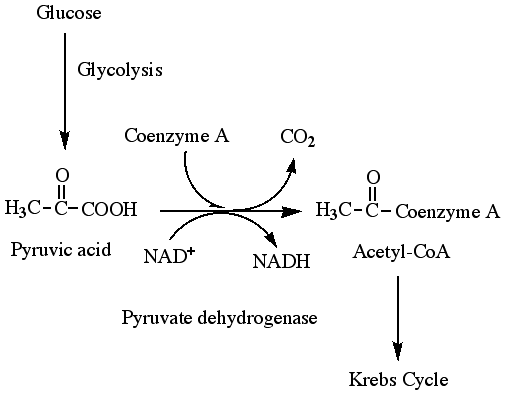Stage 1: Glycolysis (anaerobic)
Glycolysis is thought to be the earliest form of energy metabolism. It is an anaerobic process takes place in the cytoplasm that produces two 3-carbon pyruvate molecules from a glucose (6-carbon sugar) molecule. There are 10 steps in glycolysis and 4 ATP and 2 NADH molecules are generated whereas 2 ATP molecules are used.
C6H12O6 + 2 NAD+ + 2 ADP + 2 P -----> 2 pyruvic acid, (CH3(C=O) COOH + 2 ATP + 2 NADH + 2 H+
ATP is required at steps 1 and 3. The hydrolysis of ATP to ADP is coupled with these reactions to transfer phosphate to the molecules at steps 1 and 3. Reactions 6 and 9 are coupled with the formation of ATP. 2 ATP are produced at step 7 and 2 more ATP molecules are produced at step 10. The net production of ATP is 2. Reaction 6 is an oxidation where NAD+ removes 2 protons and 2 electrons to produce NADH and H+, 2 NADH molecules are generated.
Stage 2: Pyruvate Oxidation (aerobic)
The two pyruvate molecules formed in glycolysis are transported through the two mitochondrial membranes into the matrix. In each pyruvate, one of the three carbon atoms is cleaved off by the enzyme pyruvate dehydrogenase. This carbon atom attached to oxygen and becomes carbon dioxide as the waste product. This process is known as a decarboxylation reaction. Then the other 2 carbon atoms make up an acetyl group and are added to coenzyme A, forming acetyl coenzyme A. A molecule of NADH is produced in this process. If there is a high concentration of ATP then acetyl-CoA is channeled into an anabolic pathway that synthesized lipids as a way of storing large amounts of energy as fat. If the body does need more energy, the two molecules of acetyl-CoA will enter the Krebs cycle where additional free energy transfers occur.
Stage 3: Krebs cycle (aerobic)
Krebs cycle is an eight-step process, and each step catalyzed by a specific enzyme. It is a cyclic process since the product of step 8 oxaloacetate (4-carbon) is the reactant in step 1, and combines with acetyl-CoA (2-carbon) which from the pyruvate oxidation to form citrate (6-carbon). By the end of the Krebs cycle, the original glucose molecule is entirely consumed. The six carbon atoms leave the process as six low-energy CO2 molecules as metabolic waste. In each Krebs cycle, 2 CO2 molecules are produced, 3 NADH, 1 FADH2, and 1ATP are generated.
C6H12O6 + 6O<SUB<2< sub> -> 6CO2 + 6H2O + energy (ATP)
know more about Krebs cycle:
Stage 4 and 5: Electron Transport and Chemiosmosis (aerobic)
NADH and FADH2 transfer the hydrogen atom electrons they carry to a series of compounds, mainly proteins, which are associated with the inner mitochondrial membrane, so called the electron transport chain (ETC). The components of the ETC are arranged in order of increasing electronegativity. Each component is reduced by accepting two electrons from the component before the chain and oxidized by losing the electrons to the component after it in the chain. Oxygen acts as the final electron acceptor in the ETC and forms water by combining two H+ from the matrix. Since it is an exergonic process, the free energy released in the process is used to move protons from the mitochondrial matrix to the intermembrane space of mitochondria. Each NADH can pump three protons whereas each FADH2 can pump two, because NADH passes its electrons on to the first protein complex, NADH dehydrogenase, and FADH2 transfers its electrons to Q, the second component of the chain. The NADH produced in the glycolysis in the cytoplasm also diffuse through the outer mitochondrial membrane into the intermembrane space, but it needs to go through the shuttles on the inner membrane to pass on to the matrix, since the inner membrane is impermeable to NADH.
Two shuttle systems:
1) Glycerol-phosphate shuttle, transfers the electrons from NADH to FAD to form FADH2.
2) Aspartate shuttle, transfers the electrons to NAD+ instead of FAD and forming NADH.
The accumulation of protons in the intermembrane space of the mitochondrion create an electrochemical gradient that stores free energy, since a higher positive charge and a higher concentration of protons in the intermembrane space (H+ reservoir) are caused. The free energy stored in this gradient produces a proton-motive force and moves protons through the ATPase complex; the free energy lost by the gradient is used as chemical potential energy to drive the synthesis of ATP. The result is 2 ATP per FADH2 and three ATP per NADH are formed. This process is known as chemiosmosis. The ATP molecules are finally produced in the mitochondrial matrix.




wo shi mei long
回复删除